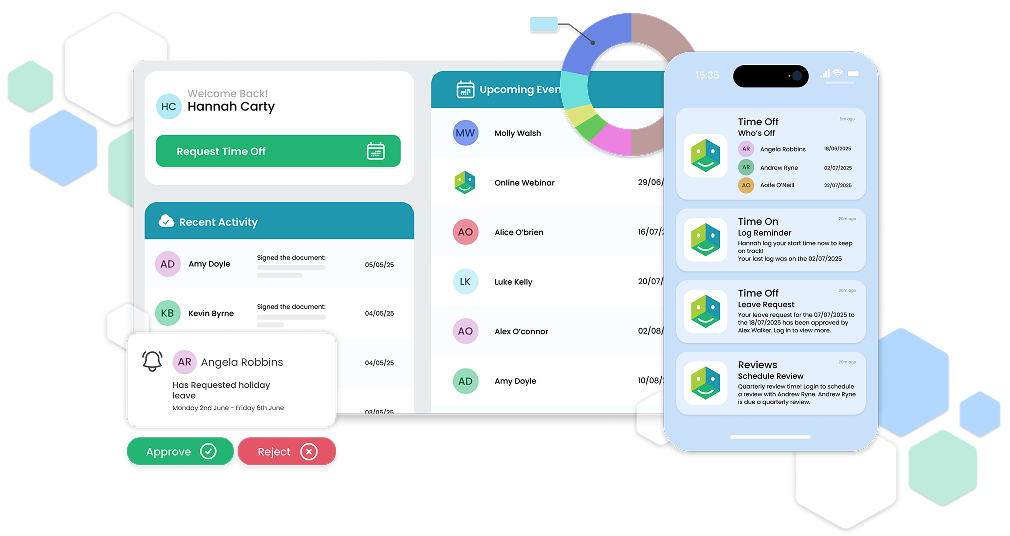Based on recent industry reports, organisations managing people and talent are facing notable shifts in pay trends, workforce management, and employee retention strategies. Keeping ahead of these developments is crucial for maintaining a competitive advantage in a dynamic job market. We have carefully reviewed the latest data to highlight the most relevant insights for HR leaders, helping to guide strategic planning. These insights focus on key areas such as compensation, workforce growth, and turnover reduction. By implementing the appropriate strategies, organisations can be well-prepared to address the challenges and opportunities that lie ahead.
Pay and Compensation Trends for 2025
Compensation management will continue to be a central focus as competition for talent remains strong. In 2024, many businesses increased basic pay as part of their strategy to remain competitive, driven by market pressures, inflation, and a tight labour market. This trend is expected to continue through 2025, though at a slightly moderated rate. Ensuring packages remain competitive will be key to attracting and retaining high-quality talent.
Importance of Competitive Pay Structures
Competitive salary benchmarking and regular reviews of compensation structures are essential to remaining an attractive employer in 2025. As inflation and cost-of-living adjustments continue to impact employees, pay remains a top factor in job satisfaction. In sectors such as tourism and retail, larger pay hikes were observed due to changes in minimum wage regulations, while some smaller businesses opted for more cautious approaches, maintaining current pay levels into the new year.
Anticipated Pay Increases in 2025
While pay increases are expected to continue throughout 2025, the pace is likely to slow slightly. Most employers are planning increases, but the average forecast suggests a more modest rise than what was observed in 2024. Balancing competitive pay with operational cost management will be a key challenge. Regular reviews of employee compensation plans, along with market-based adjustments, will help maintain satisfaction and minimise turnover.
Workforce Growth and Hiring Strategies for 2025
Another key area to focus on is workforce expansion. While many businesses are still planning to grow their teams, the rate of workforce expansion is expected to slow slightly compared to the rapid hiring seen in 2024. This means more strategic approaches are needed when it comes to hiring and workforce planning.
Strategic Workforce Planning
With rising hiring costs and ongoing recruitment challenges, 2025 will require a more strategic approach to workforce growth. Workforce planning needs to balance business expansion with operational efficiency. For example, in sectors like technology and manufacturing, where the demand for skilled workers is high, focus should be on finding talent with specific skill sets that align with long-term objectives.
Investing in Talent Development
One solution to address hiring challenges in a more constrained job market is to focus on talent development within the organisation. Offering training and upskilling programmes ensures employees are equipped with the skills needed to meet future demands. By investing in the growth and development of current employees, businesses can reduce reliance on external hiring while also improving retention.
Flexible Working and Remote Workforce Strategies
The rise of remote working and flexible working arrangements has been one of the most significant workplace trends in recent years. In 2025, remote working options remain a key factor for attracting top talent. Crafting policies that support flexibility while maintaining productivity and collaboration across distributed teams will be essential.
Employee Retention Strategies for 2025
Employee retention is expected to remain one of the biggest challenges in 2025. While turnover rates have improved in some sectors, they continue to be a major concern in industries like services, where high levels of employee movement are common. Reducing turnover is essential for maintaining continuity, especially as businesses navigate a slower hiring environment.
Career Development and Progression
One of the most effective ways to retain employees is by offering clear career development opportunities. Employees are more likely to stay when they see a clear path for growth. Implementing robust talent management strategies that allow for development, mentoring, and internal promotions can significantly reduce turnover.
Employee Wellbeing and Engagement
Employee wellbeing will continue to be a key focus area. Prioritising initiatives that promote both physical and mental wellbeing, as employee health is closely tied to retention and productivity, will be necessary. Employee assistance programmes (EAPs), flexible working arrangements, and wellness incentives can all contribute to a more engaged and healthier workforce.
Turnover Reduction and Retention Metrics
As part of retention strategies, it’s important to monitor retention metrics. Monitoring data such as employee turnover rates, exit interview feedback, and employee satisfaction scores can provide valuable insights into areas that need improvement. Using this data to inform decision-making can develop more effective retention programmes tailored to the workforce’s needs.
What HR Professionals should look forward to in 2025
As we move through 2025, the HR landscape will continue to evolve, presenting new challenges and opportunities. In a world where the competition for talent remains high, staying flexible and adaptable will be key for long-term success. Key focus areas, including competitive pay structures, strategic workforce planning, employee development, and retention strategies, will be important for navigating the year ahead. While external hiring may slow, developing internal talent and creating employee loyalty will be essential to organisational growth.
The continued rise of remote and hybrid workforces will require rethinking engagement strategies, communication methods, and performance metrics. Providing employees with flexibility while ensuring productivity and connection will be a balance to manage in 2025.
This post highlights key trends from recent industry reports, including insights from the Ibec 2024 HR Update Survey, 2024 CIPD HR Practices in Ireland Report and HR Barometer report from Adare HR.










